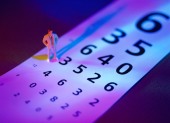- Fragments of Bird Flu Virus Found in 1 in 5 Milk Samples
- Clients Got HIV Through ‘Vampire Facial’ Microneedling Treatments
- Take the Stairs & Step Up to Longer Life
- ‘Drug Take Back Day’ is Saturday: Check for Leftover Opioids in Your Home
- Loneliness Can Shorten Lives of Cancer Survivors
- A Stolen Dog Feels Like Losing a Child, Study Finds
- Healthier Hearts in Middle Age Help Black Women’s Brains Stay Strong
- Better Scans Spot Hidden Inflammation in MS Patients
- Which Patients and Surgeries Are ‘High Risk’ for Seniors?
- Vancomycin May Be Losing Strength Against Common Deadly Infection
Age-Related Eye Differences May Cause Falls


Older adults are far more likely than young people to have vision differences between their eyes. This could increase their risk for falls if they don’t get the correct vision prescription for each eye, researchers say.
The new study followed nearly 120 seniors, average age 67, for 12 years. The researchers looked at the participants’ development of anisometropia, defined as a significant difference in prescription between the two eyes in one of four areas.
By the end of the study, the number of participants needing a different prescription for each eye doubled to 32 percent, according to the findings in the journal Optometry and Vision Science.
Most cases were related to differing degrees of farsightedness between the eyes, while others were caused by unequal blurring of the lens of the eye. The researchers also found that differences between the eyes could begin at any age, and that the difference actually decreased in a few patients.
Previous studies have shown that only 2 percent to 4 percent of children have anisometropia, the study authors noted in a journal news release.
“Whatever the cause of the increase in anisometropia with aging, the fact that significant anisometropia is at least 10 times more common in those over 75 years of age than in children needs to be clearly emphasized to clinicians,” wrote study leader Gunilla Haegerstrom-Portnoy of the University of California, Berkeley, and colleagues.
They said their findings highlight the importance of appropriate vision correction in both eyes for older adults.
Uncorrected anisometropia is likely to lead to vision disturbances that may contribute to falls in the elderly, the researchers noted.
Journal editor-in-chief Anthony Adams agreed.
“For older people a lack of correction of this prescription difference between the eyes may contribute to the increased frequency of falls that, in turn, can have a severe impact on health and even life expectancy,” he said in the news release.
More information
The U.S. National Eye Institute has more about aging and eyes.
Source: HealthDay
Copyright © 2024 HealthDay. All rights reserved.









